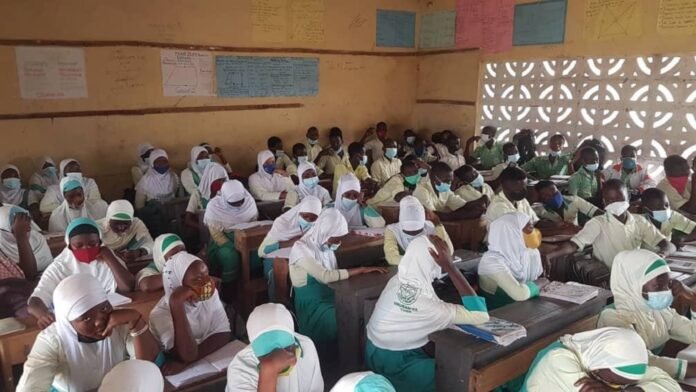
Ghana’s High Urban Class Sizes And The Pedagogical Approaches Of The Standard-Based Curriculum
Introduction
The year 2019 ushered in a new academic dawn in Ghana’s basic education with the introduction of a standard-Based Curriculum to replace the nation’s longstanding Objective-Based Curriculum that was based on preparing learners to pass examinations to one based on the acquisition of 21st Century skills1. Pursuant to the Ministry of Education (MoE) endorsement of a quality learning experience for all, the Standard-Based Curriculum rightly focuses on learning, and learning progression, using recommended participatory and creative pedagogies2.
The success or otherwise of an effective StandardBased Curriculum implementation rests on three critical determinants; availability of teaching and learning resources, acquisition and adoption of the recommended pedagogic skills and a recommended class size. This Policy Brief focuses on the implications of pedagogic skills and large class sizes on the effective implementation of Ghana’s Standard-Based Curriculum, while recommending policy measures to reduce class sizes in urban Ghana.
Pedagogical pre-requisites for effective curriculum implementation
As indicated, the recommended pedagogical approach stipulated by the National Council for Curriculum and Assessment (NaCCA) for effective implementation of the Standard-Based Curriculum includes Social Constructivist; Learning-centred teaching; Teaching-centred schools; Inclusion; Scaffolding; and Differentiation. These approaches are critical to the attainment of the six essential core competencies (Communication and collaboration; critical thinking and problem solving; creativity and innovation; cultural identity and global citizenship; leadership and personal development and digital literacy). The MoE through the $ 218 million Ghana Accountably and Learning Outcomes Project (GALOP) is building the capacity of teachers in the adoption of creative and participatory pedagogies to facilitate the effective implementation of the Standard-Based Curriculum.
According to the Ministry, all teachers have been engaged and continue to participate in various pedagogical skills development interventions. However, the outcomes of these pedagogical capacity building interventions for teachers are likely to be constrained by the large class sizes in most urban schools, taking into cognisance the MoE’s suggested class size of 35 for primary and 25 for Junior High School (JHS).
Ghana’s large urban class-sizes
The MoE reports a Pupil-Teacher Ratio (PTR) of 26 (primary) and 12 (JHS) suggesting Ghana’s primary and Junior High Schools (JHS) have one teacher handling between 12 and 26 pupils in a class. However, in many urban municipalities, there is no significant correlation between the PTR data and class sizes. For instance, the average basic school class size in Greater Accra region is 50 pupils, with schools like AdMA Model Basic School (Adentan), Oyibi Presby Primary (Kpone Katamanso) and Umraniya Islamic Basic School (Ga South) recording between 80 to 100 pupils in a class. This situation is a result of the lack of adequate classrooms in urban areas amidst a regional teacher surplus.
Table 1 presents selected municipalities in Greater Accra with large class sizes. The Kpone Katamanso Municipal leads the Primary category with an average of 60 students per class whiles Weija Gbawe Municipal tops the JHS category with an average of 76 students per class, even though PTRs are low and within the recommended targets.
The implication of such crowded classrooms will be the Standard-Based Curriculum, being implemented with an old and ineffective talk-chalk, teacher centred pedagogical approach.
Table 1: Average class sizes and PTRs in selected urban municipalities in Greater Accra Region.
District Primary Class Size Primary PTR JHS Class Size JHS PTR Weija Gbawe 61 38 72 19 Adentan 65 25 60 13 Ga West 62 28 69 14 Kpone Katamanso 71 25 68 18 Ga North 61 22 66 12
Source: EMIS, 2019/20
Basic education financing deficits and large class sizes
The status quo is the result of declining investments in basic education infrastructure against an ever-growing youthful population.
There has been a gradual decline in basic education’s share of the education sector expenditure from 55.7% in 2008 to 40% in 2020.
The Ghana Education Trust Fund (GETFund) and the District Assemblies Common Fund (DACF), used in financing basic education infrastructure have been depleted with the capping and securitization of portions of the former, and liquidity issues causing delayed and inadequate release of the latter.
Even though the MoE secured a $1.5 billion loan to expand education infrastructure in 2019, which occasioned the securitization of the GETFund, the focus has been on expanding secondary school infrastructure, in line with the highest political priority accorded the free Senior High School policy.
Population growth versus schools’ growth
Ghana’s population is youthful, with about 42 percent aged between 0 and 14 years. Between 2010 and 2021, while the population of Greater Accra grew by about 36% (from 4.01 10million to 5.45 million11), there was only an 11% increase in the number of public basic schools in the Region.
In a fast-growing lower middle-class municipality like Adentan where the population increased from 78,000 to 111,000 between 2010 and 202112, the number of public primary schools has only increased by 4% in the past ten years. Obviously, the growth in Greater Accra’s urban population has outpaced its growth in public basic schools over time, causing pressure and overcrowding in the few available classrooms.
Conclusion
Quality learning outcomes can only emerge from the effective implementation of Ghana’s StandardBased Curriculum. However, its effective implementation depends on the provision of teaching and learning resources, the development and adoption of participatory and creative pedagogic skills, and most importantly the existence of recommended class sizes that supports participatory and creative teaching and learning.
Recommendations
In the short term, thousands of new classrooms are required to reduce the large class sizes experienced in Ghana’s urban basic schools. The MoE must be intentional in reducing class sizes in urban schools by rolling out a deliberate programme to build more classrooms in overcrowded schools.
In the medium term, there is the need for an infrastructure policy that approaches school expansion by relying on existing and projected class sizes and the need to reduce the distance commuted to school. Further, in addition to PTR, class sizes must inform policy planning.
Financing is key to implementing a responsive infrastructure plan. The MoE and the Parliamentary Select Committee on Education must engage the Ministry of Finance on amending the Earmarked Funds capping and Realignment Act, 2017 (Act 947) to exempt GETFund, thereby freeing resources for basic education infrastructure expansion.
In addition, the payment of DACF arrears and timely release of ensuing tranches must be prioritized, as Ghana embarks on its journey to fiscal recovery. Releasing the DACF timely will ensure the completion of some abandoned school projects.
Finally, to enable quality measurement and monitoring for accountability, EMIS data must capture new classrooms added in existing schools different from new schools constructed.
The author, Kofi Asare is the Executive Director of Africa Education Watch. He has two decades of experience working with governments, local and international organizations, private sector in education and skills policy advocacy and research across Africa. Email: kasare@eduwatch.info
Source: Ghana/Starrfm.com.gh/103.5FM



